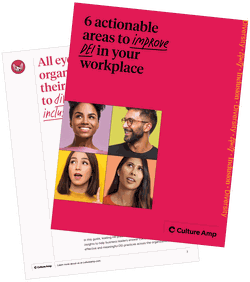
Article

Written by

Senior Content Marketing Manager, Culture Amp
“It’s just a joke.” “You know that’s not what I meant.” For many folks from marginalized communities, these offhand remarks are something they hear regularly – and often in response to them expressing their hurt and pain.
An Asian-American woman born in America may hear such phrases when she expresses offense at the question: “Where are you really from?” A Black man’s hurt may be belittled when he’s told he’s “overreacting” when a co-worker calls him “one of the good ones.” And someone from the LGBTQ* community may be considered overly sensitive if they get fired up when someone remarks: “That’s so gay!”
Most of the time, it’s true that the speaker has no intention of causing offense or pain. People are often unaware of how their words or actions impact the recipient, whose experiences differ so much from their own. But regardless of intention, these instances of “microaggressions” have real effects on people’s lives. Much like unconscious biases, being unaware isn’t an excuse for perpetuating harmful behaviors or beliefs.
In this blog, we’ll briefly discuss the various types of microaggressions and how they manifest at work. We’ll also share tips for how you can respond to and grow from being told you’ve committed a microaggression.
Kevin Nadal, a professor of psychology, defines microaggressions as:
“The everyday, subtle, intentional – and oftentimes unintentional – interactions or behaviors that communicate some sort of bias toward historically marginalized groups."
Microaggressions happen everywhere, including at work. We may call microaggressions “micro” aggressions, but their cumulative impact can be measured on a “macro” scale. Day-by-day, slight-by-slight, microaggressions can feel like "death by a thousand papercuts." Given that most folks spend the majority of their lives at work, microaggressions in the workplace have a profound impact on people’s mental, spiritual, and even physical health. That's probably part of why only 3% of Black employees reported wanting to return to the office full-time, compared to 21% of White workers. For all these reasons, we believe that understanding and reducing the occurrence of microaggressions is essential for building a better, more humane world of work.
Microaggressions usually emerge from our deeply-rooted biases against those who are different from us. Frequently a result of our upbringing, many folks don’t know they possess these biases until they come face-to-face with them in a conversation or confrontation. That being said, it’s human to make mistakes. Our perspectives are limited, and it’s natural not to understand how every other community experiences the world. What matters most is how we choose to respond once we’re made aware of our biases and the ways they manifest themselves as microaggressions.
By definition, microaggressions are a comment or action that negatively targets a marginalized group of people. Communities or identities that can be targeted include, but are not limited to:
Often, folks exist at the intersection of many overlapping identities (e.g., an Indigenous trans woman or a disabled immigrant). Thus, microaggressions can be intersectional. For example, an Indigenous trans woman may encounter microaggressions on the basis of her race, her gender, being trans, or any combination of the three.
One study from the Teachers College at Columbia University identified subgroups of microaggressions. While the study itself focuses on racial microaggressions, we find that the definitions, which we've rephrased below, can also be applied to microaggressions more broadly.
Microaggressions, in all its forms, can manifest themselves verbally, behaviorally, or environmentally. Below are a few examples of how microaggressions can show up at work.
A verbal microaggression occurs when someone says something offensive or disrespectful to a marginalized group. Some examples include:
A behavioral microaggression is an insensitive or problematic action that often plays into identity stereotypes. This might look like:
Environmental microaggressions are expressed in society through a lack of representation, inclusion, and diversity. This often manifests through:
Microaggressions can significantly and adversely impact organizational health by creating a toxic work culture that corrodes employee engagement and overall employee experience. Experiencing microaggressions can steadily wear away at everything from performance, sense of belonging, current and future development, to retention, and more. Not least of all, microaggressions can undermine your organization’s diversity, equity, and inclusion efforts and stagnate the innovation afforded by diverse perspectives.
Almost everybody has committed a microaggression before, but not everybody is accustomed to being called out and responding with grace. Accepting criticism is difficult for the best of us, no matter how enthusiastically we embrace the idea of unlearning our biases. That’s why it’s important to treat these confrontations as learning moments, rather than personal attacks. Just because you’ve said something problematic doesn’t mean you are a helplessly problematic person. If you listen to others’ concerns with an open heart and mind, you can make significant progress in aligning your words and actions with your ideology.
With that said, here are a few things to keep in mind if you are approached by someone who is concerned or hurt by something you have said or done:
That being said, you shouldn’t expect folks from marginalized communities to do the heavy lifting for you. The burden of teaching has historically fallen on folks from underrepresented backgrounds, but it’s time we did our own homework.
As you walk away from the conversation, try not to hyper-focus on your guilt, or worse, to treat what happened like a one-time fluke. Instead, use the encounter as a springboard for driving personal, or even organizational growth.
Here are a few ways to productively channel the experience into meaningful action at your company:

We’re all biased, we all make mistakes, and we’ve all probably committed microaggressions against others. That doesn’t mean our imperfections are an excuse for the problematic or insensitive ways we interact with others. It’s not about accepting your biases as inevitable – it’s about recognizing how they affect others and untangling them from your core beliefs and behaviors.
Every individual at a company shifts the needle on inclusion and belonging. That’s why building a truly diverse, equitable, and inclusive workplace begins by making an honest effort to educate yourself, embrace unfamiliar perspectives, and act thoughtfully and intentionally.
These resources are by no means exhaustive and have been broadly placed into several, equally non-exhaustive categories. Many of the resources focus on incredibly intersectional issues and identities but are listed only once for ease of reference.
General
Gender
Age
LGBTQIA*
Racial/Ethnic Identity
Religion
Citizenship status
Disability

Learn how to understand and improve DEI across your organization.